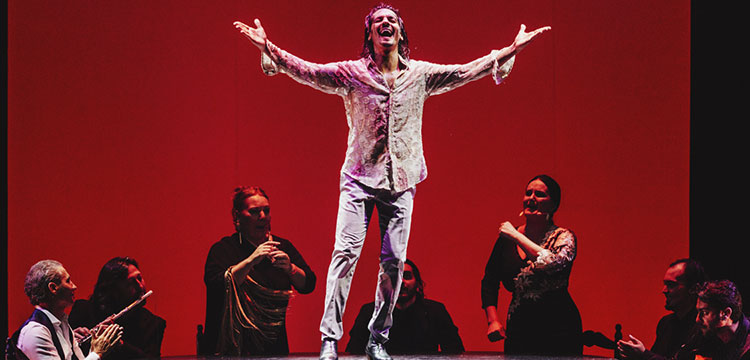“Long live flamenco, forever and ever…only flamenco” proclaimed Farruquito in the final bow of a refreshing show apt for fans of classic flamenco.
Estela Zatania
Dance: Farruquito, Gema Moneo. Dance and rhythm: Barullo. Guitar: Yerai Cortés. Voice: Mari Vizárraga, Antonio Villar, María Mezcle. Bass and piano: Melchor Santiago. Flute: Juan Parrilla. Percussion: Paco Vega. Dance, percussion and rhythm: Polito. Special guests: Pitingo, Jorge Pardo. Teatro de la Maestranza, Saturday, September 8th, 2018. 8:30pm
I got to the Maestranza theater, had the standard beer with friends at the bar on the corner, headed for my seat and glanced at the program, scrupulously avoiding any text that might be construed as a libretto, because what you can’t say with art, I have no interest in reading about.
And yes, there’s text. But it’s not about Greek gods or the essence of life nor oppression. In fact, it’s nothing more than biographical notes about Juan Manuel Fernández Montoya and a declaration of his intentions to deliver flamenco without artifice. The title of the work…it seems strange to call this kind of half-improvised show a “work”…is “Farruquito”. Just like that. Just like years ago, when a show was announced with the name of the principal interpreter and you lined up to get your ticket, not blindly, but knowing what you were going to see: in this case, the most accomplished interpreter of a school of flamenco dancing that heads the favorites list of many fans. Farruquito is a genius who has managed to distill the essence of home-grown amateur dancing, crossed with the sheen and discipline of stage dancing, resulting in an irresistibly flamenco product.
Once again, Farruquito came with some new moves. If you follow his performances closely, you see how he begins to toy with certain movements, develops them, squeezes out their potential and discards them to seek out others in a permanent questing. Flamenco never limits him. On the contrary. It gives him wings.
Guest artists (i.e. box-office bait) came in the form of two stars, Pitingo and Jorge Pardo; also announced was Diego el Cigala although he was unable to appear according to Farruquito “because he got hung up in the rehearsals”. The most imposing presence was the spiritual one of grandfather Farruco who was represented by canes, his characteristic hat, an empty chair and his soleá dance evoked by a projected shadow.
The guitar accompaniment of Yerai Cortés was brilliant, although there was some difficulty in accommodating male and female voices in a single piece. Mari Vizárraga, a singer who has been with Farruquito for decades, was over-the-top for some, and wonderfully flamenco for others, including yours truly. Singers María Mezcle and Antonio Villar, let themselves be carried away by the communication established by Farruquito with their voices, and the energy he generated; the man gets spectators so worked up, the audience’s enthusiastic cheering is almost more exciting than the dancing. The place the Farrucos inhabit is a parallel world in which life cannot be understood unless it comes in rhythmic intervals.
Other elements: siguiriyas, a stylized taranto…the Farruco style is less potent in binary measures…a large round table that serves as a mini-stage, the sweetness that flows from Juan Parrilla’s flute, an original percussion solo by Paco Vega that was much-applauded, in addition to the rhythm and dancing of Barullo and Polito, and bassist-pianist Melchor Santiago, a well-constructed coherent back-up.
Jerez dancer Gema Moneo in a white bata de cola, interpreted some fanciful cantiñas, moving the long train the way dancers did decades ago, with elegance and subtlety. A lyrical pas de deux with Farruquito appeared contrived to me, but was well-received by the numerous audience. In fact, audiences have evolved just as flamenco has: last night there was some hushed grumbling on the way out that it had been too much “flamenco flamenco”…and wee me had been so grateful for that precise reason.
Just as it makes no sense to attend a show described as “experimental avant-garde risk-taking” (always watch out for those adjectives) in search of classic flamenco, anyone who attends a presentation of Farruquito’s expecting to find gratuitous conceptualism is going to be disappointed.
Photos: Óscar Romero -La Bienal
